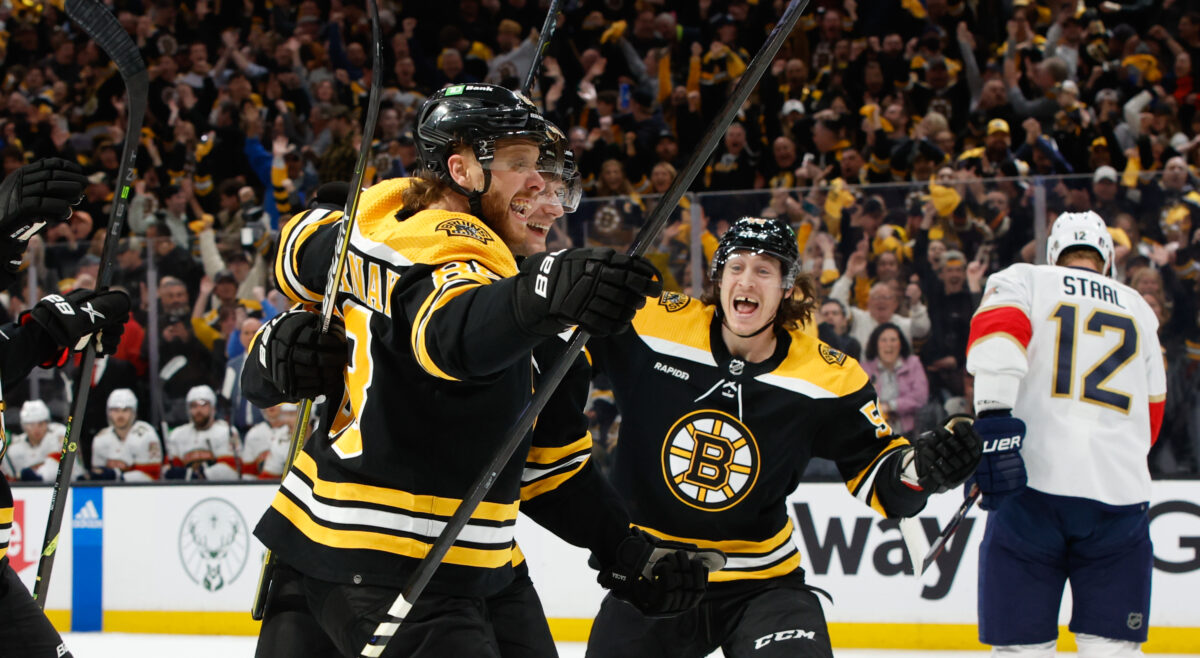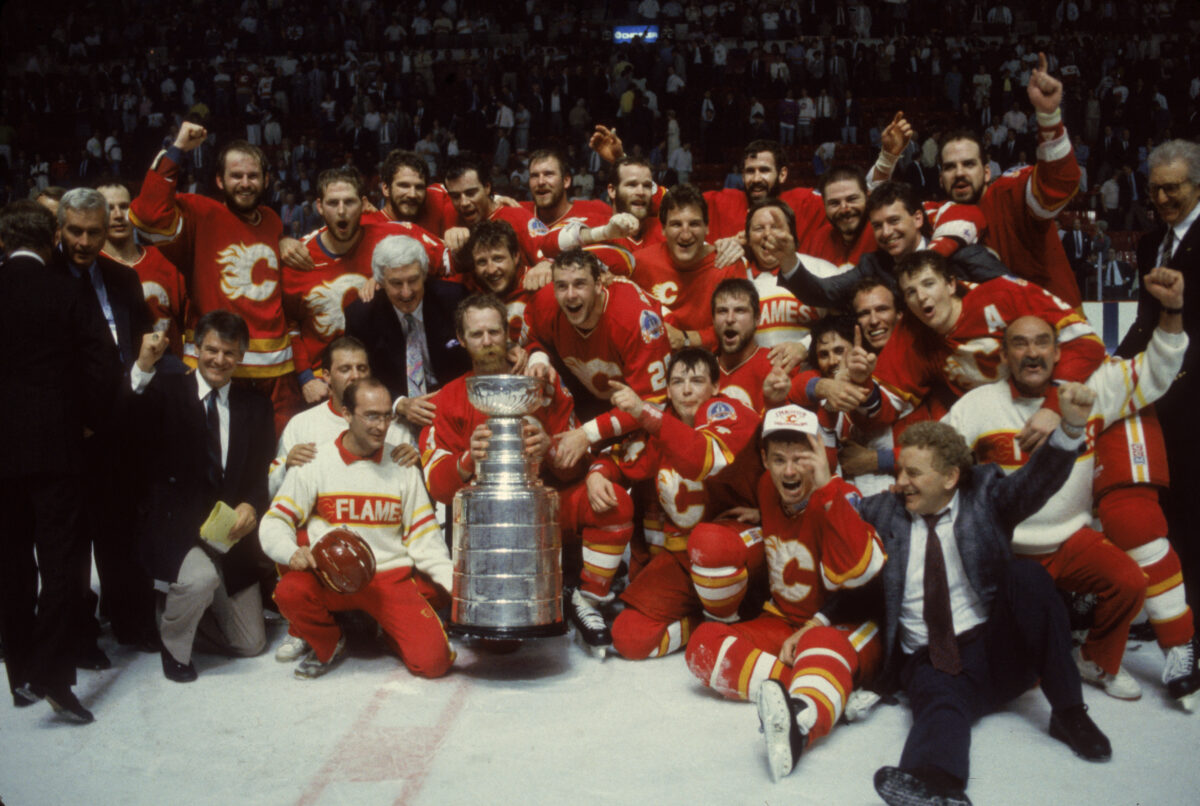The Boston Bruins made history in 2022-23, finishing with 65 wins and 135 points, the highest totals any team has accumulated in the 100-plus years of the NHL, surpassing the 2018-19 Tampa Bay Lightning’s 62 wins and the 1976-77 Montreal Canadiens’ 132 points. Their performance put them in conversation as one of the greatest teams of all time and their success in the playoffs seemed almost guaranteed.
The key, however, is almost. Over the last decade, no team has won the Presidents’ Trophy as the NHL’s best regular season team and the Stanley Cup. Not even the record-setting Lightning could do it, giving rise to the idea of the “Presidents’ Trophy Curse.” Since the trophy’s inception in 1985-86, only eight teams have gone on to win the Cup, and since the Blackhawks did it last, most recipients have bowed out in the first or second round.

It struck the Bruins in 2023 too when they lost their first-round matchup against the Florida Panthers in seven games.
The Prince of Wales Trophy
Before we look at the curse, we need to look at what the NHL was like before the Presidents’ Trophy, and unsurprisingly, without the trophy, there was hardly a curse.
In the early years of the NHL, the league didn’t have the authority to award the Stanley Cup to their playoff champion as it was shared with the Pacific Coast Hockey Association (PCHA) and the Western Hockey League (WHL), allowing the Winnipeg Victorias, Seattle Metropolitans, and Victoria Cougars to engrave their names on the Cup, even though they never played in the NHL. But in 1926, feeling unable to keep up with the rising salary demands from players, the WHL and PCHA ceased operations, leaving the coveted trophy in the hands of the NHL.
The NHL already awarded the Prince of Wales Trophy to their league champion, but with the Stanley Cup now serving as the top prize, the Prince of Wales was repurposed as a regular-season award. From 1927-1938, it was awarded to the best American Division team, while the O’Brien Trophy (another former league prize) was awarded to the best team in the Canadian Division. But the NHL was rather turbulent in that era, and before long, there were only enough teams to have a single division. So, rather than get rid of the Prince of Wales Trophy, it was instead awarded to the best team in the regular season, becoming the first iteration of the Presidents’ Trophy.
In the 29 years the trophy was awarded to the top regular-season team, 16 recipients went on to also win the Cup with eight second-place teams able to steal it away. That’s an 83 percent success rate from the top two teams in the league and certainly no evidence of a curse. However, with only six teams for the majority of the era, it was easier for the best teams to become dominant. It also didn’t hurt that, from 1939-1942, the first-placed team was given a bye to the second round of the playoffs and was allowed to play a best-of-seven series rather than a best-of-three.
No Award, No Curse
In 1967-68, the NHL doubled in size and thus was forced to once again restructure its divisions and playoff format, returning to a two-division setup and dual trophies at the end of the regular season. Initially, all the expansion teams were placed in the West Division, with the first-place team competing for the Clarence S. Campbell Bowl, while all the Original Six teams were in the East Division and played for the familiar Prince of Wales Trophy. That meant there was no longer a trophy for the regular season champion, but the NHL decided it didn’t need a replacement and just got rid of the award altogether.
However, due to the new divisions, the Prince of Wales trophy retained an unofficial title as league champion as the winner generally was the best team in the NHL and frequently went on to win the Cup. Even after the league realized its mistake and restructured the divisions in 1970-71, the team who won it still was the playoff favourite. From 1967-1985, the Prince of Wales winner won the Cup 13 times, while the team with the most points won it 10 times. More impressively, only 37 percent of first-place teams failed to win the Cup, and just 28 percent didn’t appear in the Final. Only the 1970-71 Bruins failed to make it out of the first round after finishing first, falling to the Canadiens who went on to win their fifth Cup in seven seasons.
Related: 10 Greatest LA Kings of All Time
By the 1980s, the NHL was up to 21 teams and had undergone several schedule changes. There were now four divisions and the playoffs now featured 16 teams rather than 12, which prompted the league to use divisional seeding rather than placing them first through 16th. That created the opportunity for some big upsets, and the initial results didn’t disappoint. From 1981-85, at least one division champion was eliminated in the first round, with three out of four winners falling in the opening rounds in 1981-82. The top-ranked team still claimed the Cup about 50 percent of the time, but the competition was becoming increasingly difficult.
The Presidents’ Trophy is Introduced
Introduced by the NHL in 1985-86, the Presidents’ Trophy returned to the days of honouring the team with the most points in the regular season. The first recipients were the Wayne Gretzky-led Edmonton Oilers, but they could not get past the Calgary Flames in the second round, bowing out in seven games. They reclaimed first place in 1986-87 and won their third Stanley Cup. The Flames were the second team to claim it, winning their first title in 1987-88, but could not get past the Oilers in the second round. Thankfully, they returned as league leaders in 1988-89 and won their first Stanley Cup.

Four years into its existence, the winner of the Presidents’ Trophy won the Cup 50 percent of the time. But then things started to get a bit wonky. It would take five seasons before another first-place team won it all, with the New York Rangers winning both in 1993-94. Another five seasons passed before it happened again, this time with the Dallas Stars in 1998-99. The Colorado Avalanche and Detroit Red Wings bucked the trend, winning both trophies in 2000-01 and 2001-02, respectively, but another six seasons passed before another team would follow suit. Another five seasons followed before the Blackhawks accomplished the feat.
Since then? Nothing. The 1995-96 Red Wings, who set the record for wins with 62, couldn’t make it past the conference final, and the 2018-19 Lightning, who tied Detroit’s record, was swept in the first round by the Columbus Blue Jackets. In fact, Presidents’ Trophy winners have failed to advance past the second round over 50 percent of the time, and since the 2004-05 lockout, the recipient has lost in the first round five times. That’s a steep decline in success after the implementation of the award, meaning that it has to be cursed…right?
The Curse Is Real…and Self-Inflicted
Some people will argue that there is no Presidents’ Trophy curse, such as Ian Cooper, who wrote, “Of the six Presidents’ Trophy winners who made first-round exits, five have come since the 1993-94 season, when the league changed from a divisional to the conference playoff format. Only once during that time (the 1999-2000 St. Louis Blues) was the team in a division that was above average. This shouldn’t be surprising. If a team dominates a weak division, its shortcomings should become apparent once it faces stiffer competition from the rest of the conference” (from “Why the NHL Presidents’ Trophy curse is a myth: Department of Hockey Analytics,” Toronto Star – 10/04/2014).
However, it’s for that precise reason that I believe that there is a curse. The best teams in the NHL are doomed to fall because they often play in weaker divisions, and thus have their win totals padded. Between 2017-18 and 2022-23, the Presidents’ Trophy winner was in the same division as the team that finished last 50 percent of the time and had the biggest gap in points in four out of six years. 2022-23 was no different, with the Bruins sitting a comfortable 67 points ahead of the lowly Canadiens in the Atlantic Division, a 13-point lead over any divisional difference. The Flames and Oilers, however, played in the Smythe Division and created the storied Battle of Alberta that saw three seven-game playoff series over seven seasons.
The reason that this discrepancy exists is due to the implementation of the draft lottery back in 1994-95, which was designed to prevent teams from tanking and to increase competition. However, in recent years, that’s shown to not be the case, regardless of what Gary Bettman claims. The last five Cup-winning rosters featured an average age under 28 years old and had at least a handful of first-round picks playing on their top units. To get those kinds of players, you need to draft them, so if there’s little chance that you’ll be able to compete for the Stanley Cup, then teams are inadvertently encouraged to sell off their top assets as soon as possible and acquire as much draft capital as they can.
The other half of the coin is the salary cap. After the draft lottery encouraged more teams to compete for the first-overall pick, the salary cap killed off any chance of a dynasty reforming. Now, top players are too expensive to keep around long-term, forcing teams to prioritize who they want to keep and who is expendable. While it was designed to keep the league more competitive, in practice, it prevents top teams from sustaining any long-term success. Before the 2004-05 lockout, six teams won the Stanley Cup after winning the Presidents’ Trophy for an average of 32 percent – low, but not awful. Since then, however, that average has dropped to an 11 percent win rate. If that’s not a self-inflicted curse, I don’t know what is.
The Fate of the Bruins
In the end, the Bruins succumbed to the curse. Boston played a total of 12 games against the Canadiens, Red Wings, Philadelphia Flyers, and Columbus Blue Jackets and lost just one game. While the Atlantic Divison was decently strong, the Metropolitan Division was much more competitive with three teams finishing over 100 points and just a six-point gap between the top three teams. The Atlantic was a bit more divided, with the Bruins sitting 24 points ahead of the Toronto Maple Leafs and 27 points ahead of the third-place Lightning.
Even if the Bruins had ended up in the Final, the Western Conference was almost guaranteed to be more difficult, as seven teams across the Conference finished with 100 or more points with a gap of just nine points.
It’s simply the reality that the NHL lives in. As long as the Presidents’ Trophy “curse” exists, the league will continue to create dominant regular-season teams that fall in the playoffs. With the NHL looking at adding even more rivalry games and increasing the schedule from 82 to 84 games, that gap is sure to increase between the top and bottom, simply due to how the draft lottery rewards teams and salary cap punishes them. This is the real Presidents’ Trophy curse, and it won’t go away until the NHL decides to fix its broken system.
Sign up for our NHL History Substack newsletter
